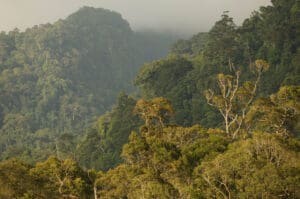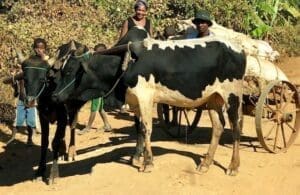A new operational guide is set to help Indigenous and local communities sustainably manage their forest concessions in the Democratic Republic of the Congo (DRC).
The Operational Guide for the elaboration of a “Simple Management Plan” is the result of extensive collaboration among organizations representing the DRC’s forest-based communities. It aims to help these communities maximize the benefits of their forest concessions sustainably as well as improve their livelihoods.
The much-needed tool was made possible with support from RRI’s “Strategic Response Mechanism (SRM),” a means for channeling rapid funding to local communities by the Coalition, helping them make the most of strategic opportunities to advance their land rights. RRI channeled its support through its collaborator, Council for Environmental Defense through Legality and Traceability (CODELT).
Why is this tool important?
Across the globe, community forestry has been proven to be an effective strategy for securing the livelihoods of communities, ensuring conservation of biodiversity and advancing the fight against climate change. The DRC is among the few Central African countries to enshrine community forestry in its national legislation.
Article 22 of Law No. 011/2002 in the DRC Forest Code states: “A local community may, at its request, obtain as a forest concession, part or all of the protected forests among the forests regularly owned by virtue of custom. Allocation terms of concessions to local communities are determined by a President of the Republic decree. Allocation is free.”
This Article has been a key milestone in involving DRC’s forest-based communities in the sustainable management of its vast forests. The law has also become a key tool for preventing land conflicts among local communities – providing a path toward long-term peace and social cohesion.
However, community forestry in the DRC has been fraught with challenges. Implementation of the Forest Code became effective nearly 12 years after its promulgation, with a 2014 decree laying out the terms for allocation of forest concessions to local communities (as provided in Article 22). Enforcement of the decree led to a rush of initiatives to help communities meet the requirements of forest concessions. Several national and international NGOs tried a host of approaches – at times in conflict with one another.
Eventually, the Forestry Administration decided the process was too messy with significant ecological consequences. These fears rose from the dangers of exploitation of local communities’ forest concessions (LCFC) that couldn’t meet the requirements of sustainable forest management. To remedy this, the Administration decided to standardize its application procedures and produce new tools to aide community forestry. It also led to adoption of additional regulatory texts in the Decree 014. These include:
- Order n ° 025 / CAB / MIN / ECN-DD / CJ / 00 / RBM / 2016, which lays down specific provisions relating to the management and exploitation of local communities’ forest concessions;
- Order n ° 018 / CAB / MIN / EDD / AAN / TNT / SAA / 2018, which approves the Strategy for community forestry in the DRC; and
- Order n ° 73 / CAB / MIN / EDD / AAN / KTT / SAA / 2018, which published the tools for implementing community forestry in the DRC.
These texts aimed to bring community forestry in the DRC in compliance with the requirements of sustainable forest management. Consequently, any community that is awarded an LCFC must comply with their regulations before using the concession.
Based on Order No. 025, the Operational Guide for the Development of a Simple Management Plan is one of the most important tools to guide communities on these regulations. Unlike holders of industrial timber logging concessions who are required to create a full development plan, the Indigenous and local communities who are assigned LCFCs need to only develop a “Simple Management Plan,” which must precede the concessions’ operation. This guide is an accessible and non-complex tool to help communities develop this management plan in accordance with guidelines produced by the Central Forestry Administration. Communities can also rely on their local forestry administration for support with the plan.
How was this Guide developed?
Even though the first LCFCs were awarded in February 2017, followed by 71 pending applications, the Forestry Administration had to put the operational guide on hold in 2016 due to financial constraints. In the absence of this guidance, the communities benefiting from the titles were unable to operate their concessions, creating major roadblocks in the implementation of community forestry.
The project to complete the guide finally began with help from the World Resource Institute and the United States Forest Service, who recruited an international consultant to create a first draft. Following initial feedback by WRI and USFS, working sessions were organized by the Community Forestry Division of the Environment and Sustainable Development Ministry to strengthen the draft. A validation workshop, held in May 2019, then tasked a committee to integrate stakeholders’ recommendations and produce a final document. Unfortunately, this committee never met due to lack of capacity and resources.
The impasse led the RRI coalition in the DRC to take action. The coalition quickly agreed to support its collaborator CODELT in taking the guide to the finish line. CODELT partnered the Tropical Forest Management Support Centre, a Congolese non-governmental organization that supports the Ministry in strengthening community forestry in the DRC. They worked closely with the Community Forestry Division to provide technical expertise, create a framework for discussion and enrichment of the draft, and ensure its ownership by key national stakeholders.
The technical work completed in August 2020, and CODELT officially submitted the guide to the Central Forestry Administration on August 31. The Guide was received by the DRC’s Environment and Sustainable Development Minister, His Excellency Mr. Claude Nyamugabo.
What’s next?
With the availability of this guide, the long wait for the country’s Indigenous Peoples and local communities to finally begin using their concessions is now over. Proper planning of the management and use of LCFCs with this guide will also facilitate the allocation of other spaces, by documenting the state of resources available to meet the needs of present and future generations.
Last but not least, finalizing the guide now will be instrumental in the success of an ongoing project to support secure land and forest rights for Indigenous Peoples and local communities in the DRC. That project, funded by The Tenure Facility, is being implemented by five RRI collaborators, and aims to secure 300,000 hectares of forests for Indigenous and local communities in five provinces (Mai-Ndombe, Kongo-Central, Kwilu, Sud-Ubangi, and Kwango).
The success of this effort exemplifies the importance of timely and practical interventions by the RRI coalition, and its unique ability to bring together various actors to achieve a unified goal: to strengthen and support the Indigenous Peoples and local communities that guard and sustain our forests.
Interested in receiving notifications about new blog posts? Subscribe to The Land Writes Blog now to get new posts delivered right to your inbox.







